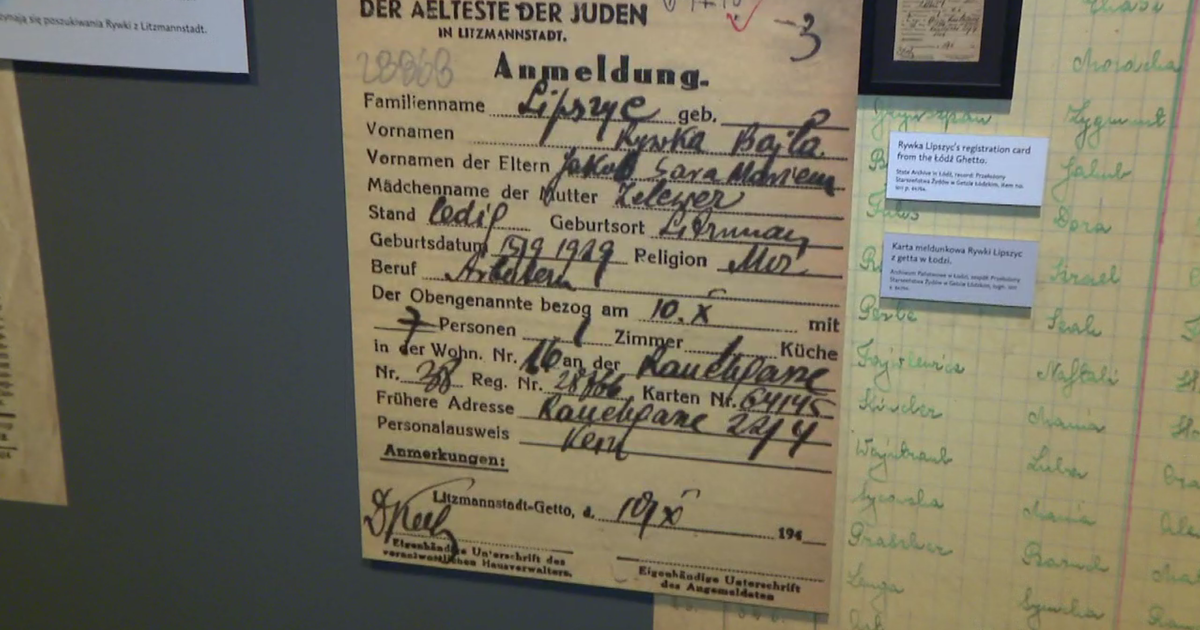Boston.com Today
Sign up to receive the latest headlines in your inbox each morning.

SKOKIE, Ill. (CBS) — A new exhibit at the Illinois Holocaust Museum documents highlights the diary of a 14-year-old girl living a Polish ghetto in the 1940s.
“The Girl in the Diary: Searching for Rywka from the Łódz Ghetto” opened on Thursday.
Rywka Lipszyc’s diary was liberated at the Auschwitz-Birkenau Camp in 1945. It was found by a Soviet doctor in the ashes of a crematorium.
The diary traveled to the United States more than 60 years after it was discovered – and it was translated into English, supplemented with commentary, and published, the museum noted.
“Only when she passed away, and her son passed away, did the doctor’s granddaughter – who had moved to the United States – find it with her family’s belongings, and brought it with her back to San Francisco,” said Arielle Weininger, chief curator of collections and exhibits at the Illinois Holocaust Museum. “At that point in time, she took it to a Holocaust researcher – who read the diary, got it translated – and only then did we find out the story of Rywka Lipszyc.”
In the diary, Rywka documented her life in the Łódz Ghetto between October 1943 and April 1944. She had already lost her siblings and parents, but never gave up hope, the museum noted.
There are no known photos of Rywka, and it is not known what she looked like, the museum notes.
The exhibit walks visitors through Rywka’s faith, hope, and fight for survival with historical artifacts and documents, interactive touch screens, documentary videos, and photographs. The exhibit also reconstructs what might have happened to Rywka after she was deported to Auschwitz.
The exhibit is on display through Sept. 24 at the museum, at 9603 Woods Dr. in Skokie.
Thanks for reading CBS NEWS.
Create your free account or log in
for more features.


Several Illinois counties that have explored the idea of secession might be welcomed with open arms in Indiana.
Legislators in Indiana’s Republican-majority General Assembly have introduced a house bill that would establish a commission to discuss whether it’s advisable to adjust the boundary between Illinois and Indiana.
The House Republicans included the bill on a list of their top priorities for the 2025 session, which specifically noted that dozens of counties in Illinois have voted since 2020 “to secede from their high-tax state,” the Indianapolis Star reported.
“To all of our neighbors in the West, we hear your frustrations and invite you to join us in low-cost, low-tax Indiana,” House Speaker Todd Huston said, according to the newspaper.
In the November election, a total of seven counties in Illinois faced a ballot question on exploring the idea of secession, and all seven voted in favor of the proposal, according to county clerks’ offices. The group includes: Iroquois, Calhoun, Clinton, Green, Jersey, Madison and Perry counties.
Prior to the 2024 election cycle, at least two dozen counties voted affirmatively on the non-binding initiatives.
The reasoning behind the referendums, according to supporters, is that the city of Chicago and Cook County have a sizable impact on the policies enacted by the state legislature, and rural counties share different interests that are not being represented by the actions of the General Assembly.
Illinois Gov. J.B. Pritzker called Indiana’s proposal “a stunt” earlier this week.
“…It’s not going to happen, he said. “But I’ll just that say Indiana is a low-wage state that doesn’t protect workers, a state that does not provide health care for people when they’re in need and so I don’t think it’s very attractive for anybody in Illinois…”
Many legal experts have expressed skepticism that such an effort could ever be successful. That group includes Illinois Attorney General Kwame Raoul, who penned a letter to the state’s attorney of Jersey County on the issue in 2023.

#10 Illinois faces #2 Iowa in Iowa City, Iowa, on Friday, January 17 at 6 p.m. CT. Follow along here for live updates from the dual.
Probable Match-ups
125: Caelan Riley, SO vs #28 Joey Cruz, SO
133: #2 Lucas Byrd, SR vs #3 Drake Ayala, JR
141: #17 Danny Pucino, SR vs #21 Ryder Block, FR, 2-2 or Jace Rhodes, SO, 5-2 or Cullan Schriever, SR, 3-5
149: #15 Kannon Webster, FR vs #3 Kyle Parco, SR
157: #22 Jason Kraisser, SR vs Miguel Estrada, FR
165: #15 Braeden Scoles, FR vs #2 Michael Caliendo, JR
174: #19 Danny Braunagel, JR vs #5 Patrick Kennedy, JR
184: #13 Edmond Ruth, SR vs #5 Gabe Arnold, FR or Angelo Ferrari, FR
197: #13 Zac Braunagel, SR vs #1 Stephen Buchanan, SR
285: #11 Luke Luffman, SR vs #13 Ben Kueter, FR

Local News
A GoFundMe page has raised more than $5,000 to assist with memorial service costs for a West Springfield woman who was found dead earlier this month in Springfield’s Forest Park.
Joann Garelli, 56, was found dead Jan. 7 in the Camp Star Angelina area of Forest Park, according to a Facebook post from Hampden District Attorney Anthony Gulluni.
Garelli’s death is currently under investigation by the Hampden District Attorney’s Office and the Springfield Police Detective Bureau’s Homicide Unit.
Andrew Santiago created the GoFundMe page to help his wife, Elizabeth Herd, pay for her mother’s memorial service, according to the page. On the page, Santiago called for an end to violence against women.
“[T]he violence and abuse of women are not taken seriously and we all need to come together as one to help prevent these attacks on women!” Santiago wrote.
The page was created Jan. 9 and will remain open until Garelli’s memorial service, which is scheduled to be held Jan. 21.
Sign up to receive the latest headlines in your inbox each morning.
/cdn.vox-cdn.com/uploads/chorus_asset/file/25822586/STK169_ZUCKERBERG_MAGA_STKS491_CVIRGINIA_A.jpg)
/cdn.vox-cdn.com/uploads/chorus_asset/file/25822586/STK169_ZUCKERBERG_MAGA_STKS491_CVIRGINIA_A.jpg)
Meta is highlighting a splintering global approach to online speech


Metro will offer free rides in L.A. through Sunday due to fires
/cdn.vox-cdn.com/uploads/chorus_asset/file/23935558/acastro_STK103__01.jpg)
/cdn.vox-cdn.com/uploads/chorus_asset/file/23935558/acastro_STK103__01.jpg)
Amazon Prime will shut down its clothing try-on program


Mapping the Damage From the Palisades Fire


Mourners Defy Subfreezing Temperatures to Honor Jimmy Carter at the Capitol
/cdn.vox-cdn.com/uploads/chorus_asset/file/25826211/lorealcellbioprint.jpg)
/cdn.vox-cdn.com/uploads/chorus_asset/file/25826211/lorealcellbioprint.jpg)
L’Oréal’s new skincare gadget told me I should try retinol
/cdn.vox-cdn.com/uploads/chorus_asset/file/25832751/2192581677.jpg)
/cdn.vox-cdn.com/uploads/chorus_asset/file/25832751/2192581677.jpg)
Super Bowl LIX will stream for free on Tubi


Why TikTok Users Are Downloading ‘Red Note,’ the Chinese App